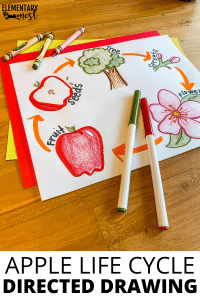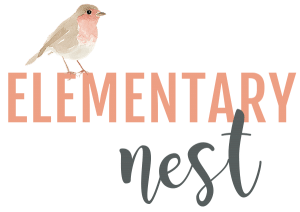
I don’t know about you, but I love doing an apple unit in September! With Johnny Appleseed and back to school, it is the perfect time to teach about apple life cycles. So, today, I am going to talk about some of my favorite apple life cycle activities!
Gather All Prior Knowledge

First, I recommend starting with a KWL chart! As you likely already know, a KWL chart is a simple way to find out what your students already know about a topic and what they want to learn. It is always important for students to access their own schema/prior knowledge and set intentions for the topic. It is interesting to hear what your students know about apples and how they think they grow! Many will be surprised to learn about the life cycle and the misconceptions they had about it. *Don’t forget to revisit this chart at the end of your unit in order to record what you’ve learned.
Start by Teaching Vocabulary of an Apple


After your KWL discussion, it is time to begin teaching! I would start with vocabulary activities. When reading technical and scientific information, pre-teaching vocabulary can make the texts more accessible to students. You want them to have some experience with the important words before running into them within their reading. Start with the parts of an apple and the stages of its life cycle. These can be introduced with a simple, labeled anchor chart; a cut, and paste worksheet; or an interactive vocabulary Mix-Pair-Share! Once they have a grasp of the important vocabulary, you can move on to your technical reading!
Gather a Go-To Stack of Apple Science Books

Be sure to have a collection of apple mentor texts for your unit. Students will be able to read them during independent reading, partner reading, small group, etc. You can even assign activities with the books, like apple life cycle vocabulary and text feature scavenger hunts! As students gain more exposure to content, they are able to turn current information into long-term stored knowledge. Here are several great books that can build upon your teaching of the apple life cycle.
- Apple Picking Day!
- An Apple’s Life
- How Do Apple’s Grow?
- An Apple Tree’s Life Cycle
- The Life Cycle of an Apple Tree
- Apples
Choral Read Passages and “Take Notes”


This unit is a great opportunity to introduce note-taking to your younger students! Use shared passages to do repeated choral readings. You want to choose texts that are accessible for most of your students so that you can read them aloud, together. During choral readings, model strong note-taking. Stop and take notes about important parts of the text. You can do this on an anchor chart at first. Then, allow students to continue their note-taking on their own. After a few choral readings, Gather together and have the students share their important notes. Create a class anchor chart, where you or the students can record information that you’ve learned!
Guide Students Through a Directed Drawing

Another fun apple life cycle activity is a directed drawing. Diagrams are going to be essential to understanding the life cycle of an apple. Students will likely see several throughout their reading, printable activities, partner talks, etc. So, it will be fun for them to draw their own! Directed drawings are a great way to reinforce the information that is important in a way that doesn’t feel like work/learning. It can break up the monotony of typical learning activities, all while building student knowledge.
Turn The Drawings Into a Group Presentation
Finally, any time a student activity can be turned into a teaching opportunity, students will grow! Have students use their directed drawings, or create a digital presentation, to share information with others. You can have small groups of 3 or 4 students present to the class. You can invite another class to come and learn from your students. Or, you could even have your students record their presentations and post them to your shared class feed so that their families can see (Class Dojo or similar).
Use this FREE Activity to Reinforce Knowledge!

FREE APPLE LIFE CYCLE ACTIVITY!
Get this fun activity sent directly to your inbox. Check your email after this!
Suggested Resources You Will Love
Would you like to plan your Fall Life Cycles unit without recreating the wheel? Below are three no-prep resources that could enhance your Apple Life Cycle unit.



If you’re looking for reading passages, cut and paste informational activities, graphic organizers, etc., check out the Fall Life Cycles No Prep Pack! If you are on the hunt for a fun, interactive, craftivity, check out the Fall Life Cycles Reading Flip Books. Or if you’d like a quick and easy lesson set (with presentations and lessons already made), take a look at the Life Cycles Lesson Slides. All three come with digital formats, too!

















